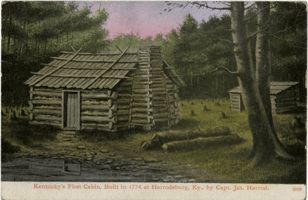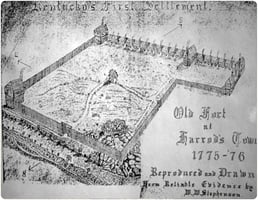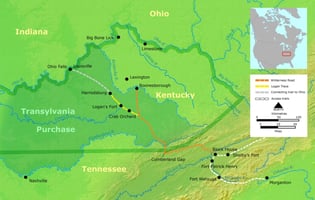Part 3: FROM STATION TO FARM
Introducing the Hanks Family, and a wedding
Nancy Hanks, future mother of President Lincoln, was born in what is now West Virginia in 1784. Her mother Lucy was unmarried, and her son Abraham said later that he was told Nancy’s father was "a well-bred Virginia farmer or planter." Nancy was raised first by her maternal grandparents, who moved their entire family to Kentucky when Nancy was an infant. Nancy was raised by family, including her aunt, Elizabeth Hanks, who married Thomas Sparrow: she called them mother and father, and was known as Nancy Sparrow. Nancy would stay close to the couple for the rest of their lives, who never had children of their own, and took in other young relatives as well. Abraham grew up knowing Elizabeth as “Granny” rather than “Aunt”. Emil Ludwig (2004). Abraham Lincoln. Kessinger Publishing. p. 20. ISBN 1417909730.
Anyone who has read about Abraham Lincoln's early life already knows the name of Dennis Hanks, a cousin to Nancy (their mothers were sisters), who was about 10 years older than Abe and spent a great deal of time with him. Dennis was also raised by Thomas and Elizabeth Sparrow: they both died of the milk sickness shortly before Abe's mother Nancy, and after that time Dennis lived with Abe and the rest of his family until he married. Dennis is one of the most important sources regarding Abe's early life: for more, you may want to read "Lincoln's Boyhood: reminiscences of his cousin and play-mate, Dennis Hanks" by Eleanor Atkinson, 1908. This short book, published 16 years after Dennis' death at age 93, was written by Eleanor as if it were a transcribed interview and is an entertaining read. https://archive.org/details/lincolnsboyhoodr00atki
Anyhow, back to Nancy. She died before the invention of photography, so we don't know much about her appearance. The image that typically represents her is an artist's conception created in the 1950s: though this image may be a good representation of "the Hanks family look" we don't know how closely it resembles her.
http://tsgsblog.blogspot.com/2010/09/markerplaquemonument-monday-nancy-hanks.html
At the time of her marriage to Tom Nancy lived with the family of Richard Berry, her uncle, who signed the marriage bond as her guardian.
From https://www.friendsofthelincolncollection.org/wp-content/uploads/2018/07/LL_1932-09-12_01-1.pdf
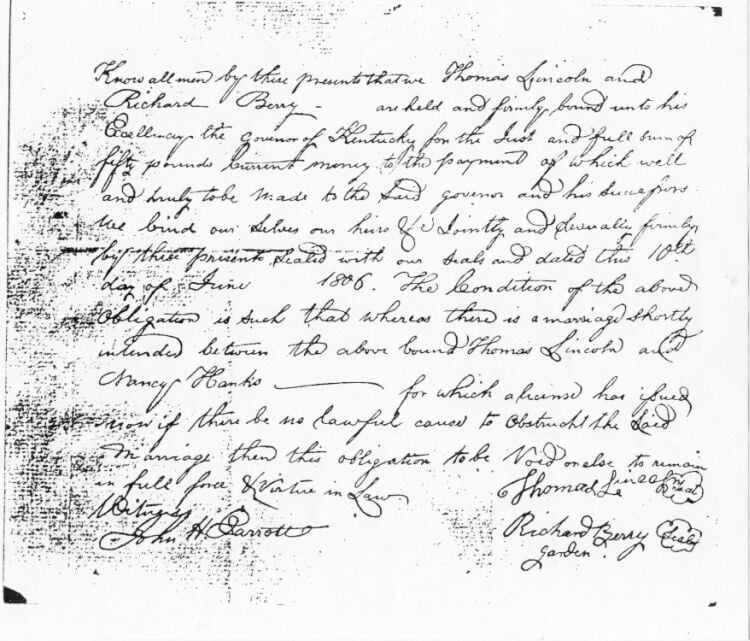
“Marriage bond between Thomas Lincoln and Nancy Hanks, dated 10 June 1806. The original is in the courthouse in Springfield, Kentucky.”
From https://en.wikipedia.org/wiki/Thomas_Lincoln#/media/File:Hank-lincoln.jpg
On June 12, 1806, Nancy and Thomas Lincoln were married in the home of Richard Berry near Springfield; that building may be visited at Old Harrod State Park, protected by a temple built in 1931.


“The bride and groom stood up before him. He pronounced them man and wife and wrote for the county clerk that on June 12, 1806, Thomas Lincoln and Nancy Hanks had joined together in holy estate of matrimony agreeable to the rites and ceremonies of the Methodist Episcopal Church. Then came the infare.” Dr. Christopher Columbus Graham, who claimed he attended the wedding, noted that “even those who happened in the neighborhood were made welcome at the wedding infare.” He told of how he heard of the wedding while “out hunting for roots,” and went “just to get a good supper. I saw Nancy Hanks Lincoln at her wedding, a fresh looking girl, I should say over 20. I was at the infare too ... We had bearmeat; venison’ wild turkey and ducks; eggs, wild and tame so common that you could buy them at two bits a bushel; maple sugar swung on a string to bite off for coffee or whiskey; syrup in big gourds; peaches and honey; a sheep that the two families barbecued whole over coals of wood burned in a pit and covered with green boughs to keep the juices in ... and a race for the whiskey bottle.”
https://parks.ky.gov/sites/default/files/listing_documents/c92fe38d11321e6c254e8a5fe4a81b42_LincolnHomesteadPktBrochtext.pdf
Tom, evidently an industrious worker, already owned a farm north of town where his mother, sister, and brother-in-law lived. The newlyweds moved to a log cabin on one of the two lots he owned just a few blocks from the center of Elizabethtown, Kentucky.
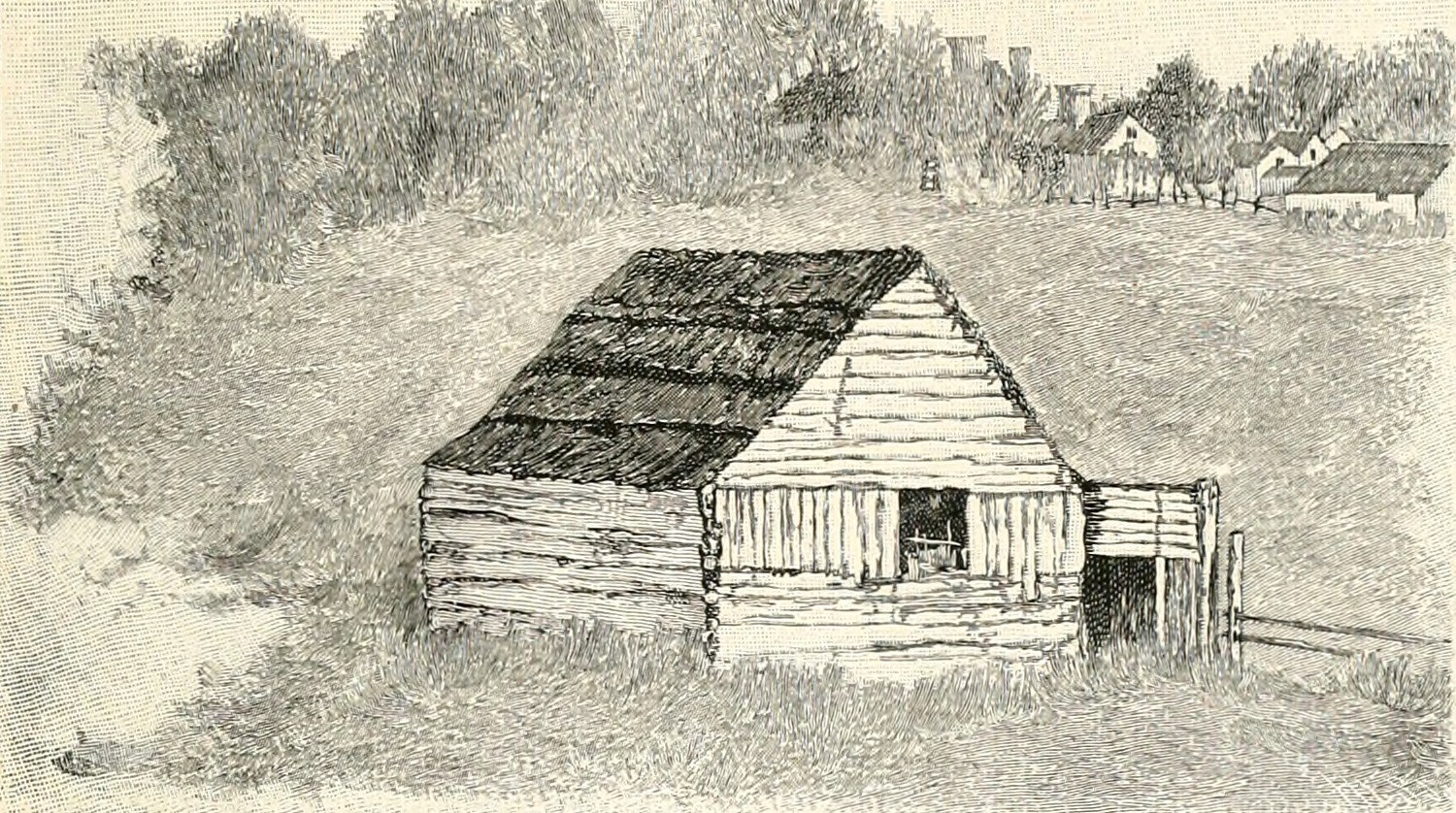
“Cabin which formerly stood on Race Street, North of the bridge over Valley Creek, Elizabethtown. Drawn by George L. Frankenstein from nature, in 1865, when tradition said it was the dwelling of Thomas Lincoln after his first marriage.”
From https://en.wikipedia.org/wiki/Thomas_Lincoln#/media/File:Elizabethtown_cabin_of_Thomas_Lincoln.jpg
Elizabethtown, less than 10 years old and with less than 180 residents, wasn’t much of a town by our standards but it was the largest settlement in the area. Few as they were, certainly having some neighbors would be beneficial to Nancy while Thomas was working as a carpenter, often at a distance from home. History of Elizabethtown, Kentucky (touretown.com) The Lincolns’ first child, Sarah, was born in Elizabethtown on February 10, 1807.
A surviving daybook from The Bleakley and Montgomery store on the square in Elizabethtown yields some interesting details about that business, and therefore life in Elizabethtown: in the month of June 1805 the store saw about 4 or 5 customers a day. The store was run by two men who immigrated from Ireland, the accounts are kept in pounds, shillings and pence – with a few entries for cash recorded in dollars. Almost half of the purchases recorded include whiskey, usually a pint at a time. The other most frequently purchased items are sewing notions (thread and buttons), fabrics (a variety were available, from rough tow linen to fabrics most likely imported from England), tea and coffee in equal frequency (though coffee was purchased in larger quantities) and twist tobacco. Only one sale was made to a woman, for dimity fabric. Three purchases included books: two people bought ‘primmers’ and one bought two bibles. Simple hardware and tools were also available, including locks and hinges, a ‘chizel’ and a whetstone for sharpening. No foods were sold, except for one purchase of nutmeg and another of ginger (most likely powdered). A few luxury items included fiddle strings, silk suspenders, and cotton stockings. Even more interesting are the entries where the store pays its customers for goods, like 9 hats, 4 bushels of oats, firewood, 80 lbs. tobacco, and 60 gallons of whiskey, or services including “hauling to Salt River” and “going to Natchez”. Thomas Lincoln was another customer who was paid by the store owners for ferrying merchandise to New Orleans down the Mississippi River, in 1806: pork and bourbon were frequent exports. (Citation for Bleakley and Montgomery Store Daybook)

